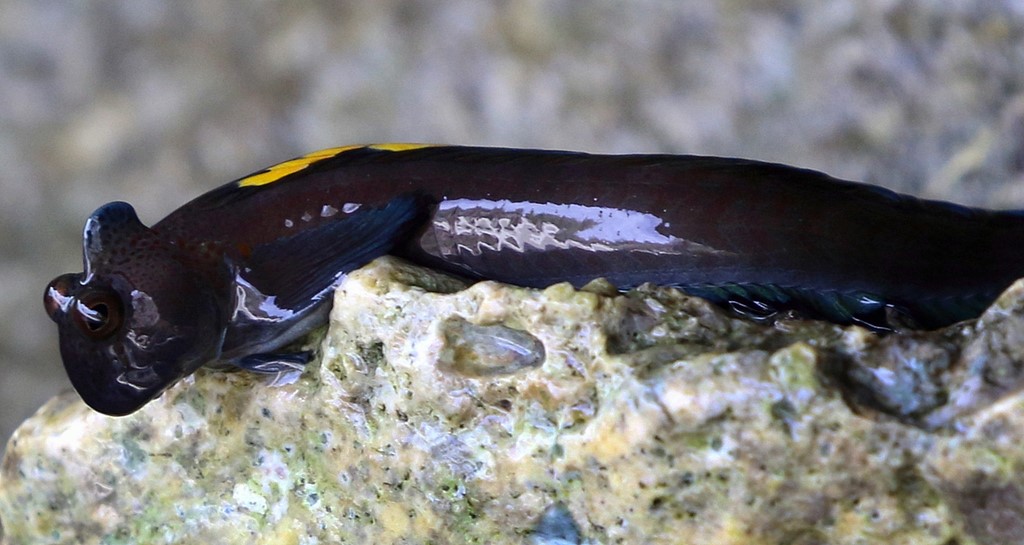ALTICUS SERTATUS - (GARMAN, 1903)
Picture courtesy of: Richard Fuller
Actinopterygii (Gigaclass) > Actinopteri (Class) > Teleostei (Subclass) > Blenniiformes (Order) > Blennioidei (Suborder) > Blenniidae (Family) > Salariinae (Subfamily) > Alticus (Genus)
Blennie sauteur couronné, Garlanded rockskipper,
Synonyme
Salarias sertatus (Garman, 1903)
----------------------
Description
Dorsal spines (total): 14-15 (usually: 15); Dorsal soft rays (total): 22-23 (usually: 23); Anal spines: 2; Anal soft rays: 27-28 (usually: 27); Pectoral fin rays: 14. Body elongate, slender, depth or length of head 1/7th of the total length. Head sort, as wide as deep, very blunt, nearly vertical in front of the eyes. A low crest on the nape. Eyes large, prominent, 1/4th as long as head. Mouth wide, inferior. Teeth very numerous, small, movable, in single series; No canines. Gill membranes continuous and free across the throat, extending higher than the bases of the pectorals. A short, flattened, fringed postorbital tentacle; No other filaments. Dorsal origin above bases of pectorals; Dorsal notch verys shallow; Extremities of rays protruding beyond the membrane. Anal origin below the 10th rays of the dorsal, rays of the fin exserted; The memebranes descend from ray to ray, forming a serrated margin. Pectoral broad, nearly straight on the upper border, convex on the hinder edge, broadly rounded on the lower margin. Caudal 1/5th of the total length, medium rays longest, separated from dorsal and anal. The rays protrude on all the fins. Max. length: 8.0 cm TL. Depth range: 0 - 5 m.
Color
Uniform dark olivaceous, lighter on the belly, anal, ventrals and pectorals; Each of the fins except the caudal with a whitish edge. Very young with more of light color on lower surfaces and fins.
Etymology
Alticus: from French, l’altique sauteur = “high jumper”. Referring to how, when grazing on algae outside the water on exposed rocks of the tidal zone, they skip and jump like wet lizards, especially when approached.
sertatus: from Latin, sertātus = wreathed, garlanded.
Original description: Salarias sertatus Garman, 1903 - Type locality: Solo Island, North Astrolabe Reef, Fiji Islands.
Distribution
Western Pacific: Solomon Islands, New Caledonia to Tonga.
Biology
Facultative air-breathing; Intertidal, found in rocky shores. Oviparous. Eggs are demersal and adhesive, and are attached to the substrate via a filamentous, adhesive pad or pedestal. Larvae are planktonic, often found in shallow, coastal waters.
Similar species
Alticus saliens (Lacepède, 1800) - Reported from Indo-West Pacific: Sri Lanka east to New Ireland (Papua New Guinea), north to Philippines, south to Vanuatu.
Last update: 10, September 2022
Actinopterygii (Gigaclass) > Actinopteri (Class) > Teleostei (Subclass) > Blenniiformes (Order) > Blennioidei (Suborder) > Blenniidae (Family) > Salariinae (Subfamily) > Alticus (Genus)
Blennie sauteur couronné, Garlanded rockskipper,
Synonyme
Salarias sertatus (Garman, 1903)
----------------------
Description
Dorsal spines (total): 14-15 (usually: 15); Dorsal soft rays (total): 22-23 (usually: 23); Anal spines: 2; Anal soft rays: 27-28 (usually: 27); Pectoral fin rays: 14. Body elongate, slender, depth or length of head 1/7th of the total length. Head sort, as wide as deep, very blunt, nearly vertical in front of the eyes. A low crest on the nape. Eyes large, prominent, 1/4th as long as head. Mouth wide, inferior. Teeth very numerous, small, movable, in single series; No canines. Gill membranes continuous and free across the throat, extending higher than the bases of the pectorals. A short, flattened, fringed postorbital tentacle; No other filaments. Dorsal origin above bases of pectorals; Dorsal notch verys shallow; Extremities of rays protruding beyond the membrane. Anal origin below the 10th rays of the dorsal, rays of the fin exserted; The memebranes descend from ray to ray, forming a serrated margin. Pectoral broad, nearly straight on the upper border, convex on the hinder edge, broadly rounded on the lower margin. Caudal 1/5th of the total length, medium rays longest, separated from dorsal and anal. The rays protrude on all the fins. Max. length: 8.0 cm TL. Depth range: 0 - 5 m.
Color
Uniform dark olivaceous, lighter on the belly, anal, ventrals and pectorals; Each of the fins except the caudal with a whitish edge. Very young with more of light color on lower surfaces and fins.
Etymology
Alticus: from French, l’altique sauteur = “high jumper”. Referring to how, when grazing on algae outside the water on exposed rocks of the tidal zone, they skip and jump like wet lizards, especially when approached.
sertatus: from Latin, sertātus = wreathed, garlanded.
Original description: Salarias sertatus Garman, 1903 - Type locality: Solo Island, North Astrolabe Reef, Fiji Islands.
Distribution
Western Pacific: Solomon Islands, New Caledonia to Tonga.
Biology
Facultative air-breathing; Intertidal, found in rocky shores. Oviparous. Eggs are demersal and adhesive, and are attached to the substrate via a filamentous, adhesive pad or pedestal. Larvae are planktonic, often found in shallow, coastal waters.
Similar species
Alticus saliens (Lacepède, 1800) - Reported from Indo-West Pacific: Sri Lanka east to New Ireland (Papua New Guinea), north to Philippines, south to Vanuatu.
Last update: 10, September 2022
